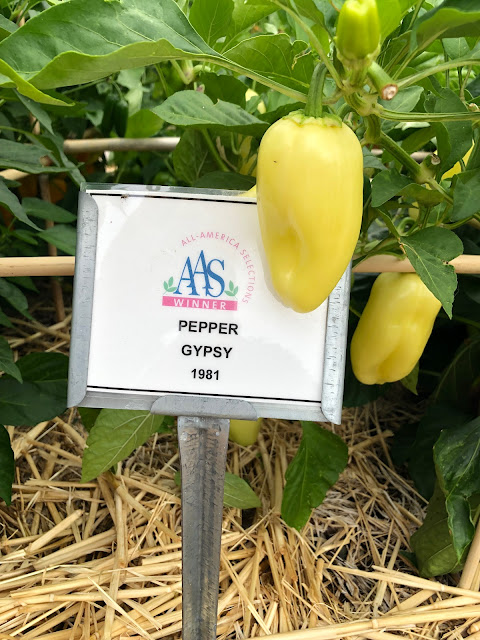
Hot August days and nights will stress gardens and gardeners

|
|
Harvest peppers to keep the plants producing. These Gypsy
peppers grow at the Fair Oaks Horticulture Center. Notice the
thick straw mulch that conserves soil moisture. (Photo:
Kathy Morrison)
|
The heat is back on! According to the National Weather Service, expect a string of triple-digit days, perhaps starting as soon as Sunday.
After a warm weekend, Sacramento’s forecast calls for 100 degrees-plus every day through at least Friday, peaking at 104 degrees on Tuesday. Overnight lows are warm, too, staying above 67 degrees.
Average for this week of August in Sacramento: High of 94 and low of 61.
Such heat is sure to stress plants -- and gardeners, too.
The good news? As hot as it will feel, we shouldn’t be flirting with any records. The hottest August day in Sacramento history: 112 degrees (set Aug. 16, 2020).
Get your chores done before 10 a.m. while the morning is still relatively cool. Water early and deeply. Remember to stay hydrated, too.
* Harvest tomatoes, beans, squash, pepper and eggplants to prompt plants to keep producing. Give your plants a deep watering twice a week, more if planted in containers.
* Squash and cucumbers refusing to set fruit? Help the pollinators, who tend not to come out in hot weather. Take a small paint brush, dip it into the center of a flower, twist slightly to gather pollen, then dip that pollen-covered brush into other flowers on the plant.
* Watch out for caterpillars and hornworms in the vegetable garden. They can strip a plant bare in one day. Pick them off plants by hand in early morning or late afternoon.
* Mulch can be your garden's best friend; it conserves moisture while blocking out weeds. But don't let mulch mound around stalks, stems or trunks. That can promote rot.
* Pinch off dead flowers from perennials and annuals to lengthen their summer bloom.
* Deadhead roses. They’ll be back in bloom in six weeks.
* Pick up after your fruit trees. Clean up debris and dropped fruit; this cuts down on insects and prevents the spread of brown rot.
* Indoors, start seedlings for fall vegetable planting, including bunching onion, cabbage, broccoli, cauliflower, kale, radicchio and lettuce.
* Sow seeds of perennials in pots for fall planting including yarrow, coneflower and salvia.
* In the garden, direct seed beets, carrots, leaf lettuce and turnips.
* Plant potatoes.
Comments
0 comments have been posted.Sacramento Digs Gardening to your inbox.
Sites We Like
Garden Checklist for week of July 21
Your garden needs you!
* Keep your vegetable garden watered, mulched and weeded. Water before 8 a.m. to reduce the chance of fungal infection and to conserve moisture.
* Feed vegetable plants bone meal, rock phosphate or other fertilizers high in phosphate to stimulate more blooms and fruiting. (But wait until daily high temperatures drop out of the 100s.)
* Don’t let tomatoes wilt or dry out completely. Give tomatoes a deep watering two to three times a week.
* Harvest vegetables promptly to encourage plants to produce more. Squash especially tends to grow rapidly in hot weather. Keep an eye on zucchini.
* Pinch back chrysanthemums for bushy plants and more flowers in September.
* Remove spent flowers from roses, daylilies and other bloomers as they finish flowering.
* Pinch off blooms from basil so the plant will grow more leaves.
* Cut back lavender after flowering to promote a second bloom.
* It's not too late to add a splash of color. Plant petunias, snapdragons, zinnias and marigolds.
* From seed, plant corn, pumpkins, radishes, winter squash and sunflowers.